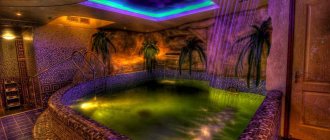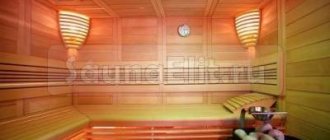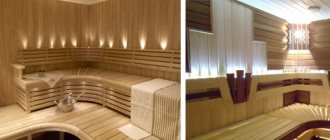Himalayan salt is a product that has been known for hundreds of years. Fans of oriental health traditions believe that it is extremely beneficial for health.
The use of salt was recorded in medieval treatises on Ayurvedic medicine. At that time it was considered a very effective remedy for many diseases.
Fans of a healthy lifestyle use this salt in their food instead of regular salt.
But more often in Russia, Himalayan salt is used for finishing saunas.
What is Himalayan salt
Rock salt (any) is a sedimentary rock. Those who remembered this while studying at school are skeptical about the term itself - the Himalayas are somehow not associated with minerals of this kind.
But skepticism is in vain. Firstly, the largest salt deposits are located in eastern Pakistan, that is, not in the heart of the Himalayas.
Secondly, salt deposits are layers of sedimentary rocks tightly compressed by the movement of tectonic plates.
As a result of volcanic activity, salt was saturated with various elements, which determined its value.
Composition of Himalayan salt
The main component of Himalayan salt is the familiar and well-known sodium chloride - kitchen salt. However, in table salt its content is 99%, and in Himalayan salt it is approximately 95%.
The rest is made up of a variety of elements - in total there are up to 84 types of them in the composition of salt.
In addition to sodium, salt contains potassium, phosphorus, iodine, magnesium, copper, calcium and many other substances.
This mineral wealth explains the popularity of Himalayan salt.
Forms of release of Himalayan salt
Salt comes on sale mainly in two forms: individual, relatively small or medium-sized crystals and large blocks of different sizes. This is done for the convenience of using salt in different areas.
Small crystals are intended for use in food and cosmetology (for baths, scrubs, rubdowns...). They are also used for some types of massage (slightly moistened with water).
Large forms are used in interiors. They are usually used in baths, but sometimes they also decorate fireplaces or are simply used as decorative elements.
Salt for interior decoration is produced in the form of cubes, bricks, tiles, blocks and panels. The purposes of many of these forms are quite similar.
Bricks and blocks are used in walls. They are held together using a special adhesive.
The tile is used as a facing material.
Cubes are the basis for the formation of decorative panels and installations. On their basis, ready-made salt lamps are made.
Is it possible to build such a bathhouse on your site or in your house?
Over the past few years, the trend of building real salt baths for private use has intensified. One of the specialized ones already has rich and successful experience in the construction of such objects. Services are provided by a professional team in Moscow and the entire metropolitan region. The equipment of a salt sauna begins with the design stage. After this, work begins on the construction of walls, roofs, and furnishing the interior with real Himalayan salt. This material does not have a service life, so the natural base will benefit you, your family and loved ones for many years.
You can build a salt steam room either as a whole complex or as a separate room in your bathhouse. Consult with experts about construction or finishing services with steamed Himalayan salt.
Source
The salt bath is the “successor” of salt caves, which were used in ancient times for healing in Greece and India. The microclimate of such caves cleansed the lungs, healed wounds and even relieved depression.
In the 21st century, you can visit a mini-version of the cave - a salt bath - in any city. The salt room is suitable for both adults and children.
Uses of Himalayan salt
One of the most common ways to use Himalayan salt is to use it in a bath. Salt is used both for decoration and as a structural element.
Himalayan bath salt in a steam room saturates the air with ions, making it similar in composition to sea or mountain salt.
Restrictions
But the possibilities for using salt are still not unlimited. And the limitations are related to the characteristics of the material itself.
Himalayan salt (like table salt) is very sensitive to moisture. Therefore, it can only be used as a decorative or structural element in a dry sauna.
The second significant limitation is price. Himalayan bath salt is an expensive pleasure, and when planning to use it in a sauna, you should carefully check the estimate.
Of course, the price issue can be circumvented by using salt “in small doses.” A small panel of Himalayan salt or a lamp will not be too expensive.
How to use
There are many ways to use Himalayan salt in a bath - not necessarily in a steam room. It can be added to water or used as a massage product.
But a more popular option is to use salt in a steam room - so that the air is saturated with its ions under the influence of high temperature. And here, too, several ways are possible.
Lighting organization
A salt lamp in a bathhouse is the most budget-friendly option for using the product. You can purchase it ready-made or make it yourself.
The lighting of the bathhouse, in which the lighting elements are placed behind a wall or panel made of Himalayan salt, will look very beneficial. When exposed to light, salt gives a pleasant warm tint.
When arranging lighting using elements made from Himalayan salt, you should not only protect the wiring elements well from moisture and high temperatures, but also think about how to make them accessible for possible repairs.
Construction of walls
You can use salt bricks or blocks to build a whole wall or a fragment of a wall in the sauna. The material is very strong and can withstand significant loads.
When planning such a construction, it should be taken into account that not only salt bricks will be required, but also special glue for connecting them. Therefore, the undertaking will be quite expensive.
You can also build a fence for the heater out of salt. It can withstand heating up to +550 degrees.
There is an alternative to a full-fledged salt wall in the bathhouse. A relatively small element is enough, as long as it is aesthetically thought out and of high quality.
Tiling
Another way is to cover the walls or individual elements of the bathhouse interior with salt tiles. Here, too, special glue and careful preparation of surfaces will be required.
Himalayan salt tiles are aesthetically pleasing and transmit light well. So it makes sense to decorate it as a luminous panel with LED strips.
The need to carefully consider the wiring design when installing bathhouse lighting using Himalayan salt has already been mentioned.
When installing tile backlighting, this note is especially important.
Can be used in steam room and panel. But we must take into account that they may require replacement relatively soon.
Laying walls of salt bricks and tiling is not the easiest task. It is better not to rely on your own strength and hire a qualified worker.
Pure aesthetics
Installations or linings made of salt can be used not only in the steam room, but also in other rooms of the bathhouse. In the rest room you can arrange a panel or install a lamp to improve the air quality.
In the steam room you can place a bowl with salt crystals. And if space allows, build an art installation from individual elements.
Who is contraindicated from taking salt baths?
Everyone should know as much as possible about the benefits and harms of a salt sauna, so as not to harm their health in the future. Do not forget that honey can cause an allergic reaction, so combining salt with honey is prohibited for people who are allergic to this product.
In addition, people with skin lesions or skin diseases should not take salt baths.
If you are planning to visit a salt sauna, you should consider a number of these rules:
- You should refrain from visiting the sauna if your body temperature has risen or you have developed any acute illness;
- adhere to a certain time spent in the steam room, as a rule, it should be no more than 30 minutes;
- It is not recommended to eat heavy food immediately before visiting the bathhouse.
But it is worth remembering that where there is benefit, there can also be harm, so it is worth clearly defining the boundaries for yourself and choosing the right regime so that the procedures are as effective as possible.
We hope this article has given everyone the opportunity to understand the benefits and harms of a salt sauna.
Extraction of Himalayan salt
It so happens that the main deposits of Himalayan salt are located in countries that are not very industrially developed. In this case, this turns out to be a plus.
Salt is extracted by hand, using the simplest tools. Therefore, it is not contaminated with harmful foreign impurities.
There is no contamination of the deposits, since there are no large industrial enterprises in the salt mining areas. Therefore, Himalayan salt is a truly environmentally friendly product.
The salt is not purified and is not saturated with additional substances. It is either crushed or, on the contrary, pressed into blocks of different shapes.
Varieties of Himalayan salt
The most popular (classic) variety of Himalayan salt is pink, salmon or meaty in color. But this is not the only option.
Iron compounds give salt its pink tint. The color depends on their quantity, as well as the presence of other impurities.
- Black Himalayan salt is not actually black, but reddish-gray. Its color is due to a significant admixture of sulfur. The same substance gives the mineral a distinct (though not too strong) “rotten” aroma, and the salt tastes like a hard-boiled egg.
- White Himalayan salt is similar in appearance to regular sea salt. It contains relatively few impurities of iron and sulfur, but compounds of other elements are present in it.
- Not only Himalayan salt can be pink In Australia, table salt of this shade is mined - its mineral composition is much poorer.
There are deposits of pink salt in Crimea. There it is obtained from the so-called “pink” lakes – Koyashsky and some others. The unusual color of water and salt is given by some algae and protozoa that can live in abnormally salty water.
Scrubs
Comprehensive skin care certainly includes a deep cleansing process. Scrubs help get rid of dead skin particles, smooth out fine wrinkles and acquire a healthy skin tone. The honey-salt mixture has a good exfoliating effect. The resulting product is suitable for the skin of the face and body.
Description of the scrubbing procedure:
- Using a water bath, heat the honey and mix with fine table salt in equal proportions.
- Stir ingredients until evenly distributed.
- Apply the finished mixture to the required areas and gently rub in with massaging movements.
- Upon completion, rinse with warm water and treat with moisturizer.
If desired, add oil (olive or essential). It is recommended to do procedures no more than 2 times a week. It is not advisable to use for owners of dry skin types.
Uses of Himalayan salt
Himalayan salt is used in various fields. Its use is determined by the ancient tradition established by Ayurvedic medicine.
Although the use of salt in a bath is the most common, its capabilities are not limited to this.
- In cooking, Himalayan salt is used in natural nutrition instead of regular salt. Its taste is slightly different, so it turns out to be a more original seasoning.
- In cosmetology, scrubs based on it are used. These products help well in the fight against cellulite and help even out skin tone.
- In the interior, salt is used as a finishing material, as well as lamps. They both decorate and improve the health of the room.
The most widespread and popular is pink Himalayan salt . But other varieties can be used similarly.
Scrubbing
Salt is perfect for scrubbing. It is especially good in combination with honey, which has a protective, moisturizing, anti-inflammatory, nourishing, rejuvenating and anti-cellulite effect.
Honey sweetness
To prepare a simple but incredibly effective scrub, you need to stock up on:
- medium or coarse salt – 2–4 tbsp. l.;
- homemade honey - ½ tbsp.;
- cinnamon essential oil – 3 drops.
Place all the ingredients in a container, mix and fill a jar or plastic container with the mixture.
We come to the bathhouse, take a steam bath, and whip ourselves with a broom. We leave the steam room and rub the skin with a viscous mass, wait 5 minutes, rinse off. Apply a nourishing mask and cream.
A scrub made from honey and salt fights cellulite and excess weight. It also has softening, exfoliating, cleansing, nourishing, restorative, and protective properties.
Coffee vivacity
To prepare the scrub you will need:
- sea, table or Himalayan salt - 3 tbsp. l.;
- ground coffee – 3 tbsp. l.;
- honey – 3 tbsp. l.
Place all the ingredients in a container, mix and fill the jar with the mixture.
After leaving the steam room, we wipe the body and apply the scrub with light movements. We massage for 3-5 minutes and wash off the mass. Then we cover the skin with a nourishing cream.
This scrub tones, invigorates, calms inflammatory processes, effectively fights “orange peel”, makes the skin soft, soft and smooth.
Oily bliss
To prepare an effective remedy, you need to arm yourself with:
- salt – 3 tbsp. l.;
- honey - 3 tbsp. l.;
- olive oil – 1 tbsp. l.;
- burdock oil - 1 tbsp. l.;
- castor oil – 1 tbsp. l.;
- linseed oil 1 tbsp. l.;
- ginger essential oil – 1 drop;
- cinnamon essential oil – 1 drop.
Place all the ingredients in a container, beat the mixture until creamy, and fill the plastic container.
Apply the substance to the steamed body, rub with light massage movements, wait 5 minutes and rinse.
Benefit or harm
It is important to understand: the benefits of Himalayan salt for humans have not yet been confirmed by solid scientific calculations. However, there is indirect information suggesting that this substance is useful.
In medicine (quite official), treatment in salt mines and artificial salt rooms has been successfully used for a long time. Since sodium chloride is the main component of Himalayan salt, it works in a similar way.
What are the benefits of Himalayan salt?
The ability to saturate the body with microelements entering through the skin, lungs or digestive system.
The disinfecting effects of salt are also known. So the Himalayan product can help heal damage and fight inflammation.
According to fans of natural therapy and natural nutrition, Himalayan salt (depending on how it is used) can
- significantly improve the condition of the respiratory tract;
- normalize the functioning of the gastrointestinal tract;
- improve water-salt metabolism, eliminate swelling;
- normalize sleep;
- eliminate excess muscle tone;
- promote weight loss;
- improve the appearance and condition of the skin.
However, we must remember that Himalayan salt mainly consists of salt - a product nicknamed “white death”. Therefore, you should not count on the fact that the mineral will provide the body with microelements - eating salt in such quantities to get the required amount from it is simply dangerous.
There are also a number of contraindications to the use of Himalayan salt in any form. Some of them are not unconditional - you should consult a doctor.
Salt should not be used if you have bleeding disorders, acute kidney disease, tuberculosis, high blood pressure, or cancer. It is also contraindicated for women in the last trimester of pregnancy.
Some skin conditions may benefit from salt, but not all. Those who have dermatological problems should consult a specialist before starting salt procedures.
Contraindications
When used in a bathhouse, you won’t be able to “overdo it” with salt consumption - the ions are not released so intensely. However, it will not be possible to take advantage of its effect on the gastrointestinal tract.
The benefits for the skin and respiratory organs have already been described above. For this reason, Himalayan salt is used in the arrangement of the bathhouse.
Contraindications for visiting a salt bath are also general. Actually, most of the health contraindications to Himalayan salt are contraindications to any steam room.
Those who suffer from skin diseases should be most careful. Before using a salt steam room, they must consult a doctor.
In principle, visiting a salt bath is recommended for diseases such as acne, eczema, psoriasis. But this is an individual matter - which is why you need a doctor’s advice.
Indications and contraindications
Sessions are indicated in the following cases:
- Chronic bronchitis, sinusitis.
- Bronchial asthma.
- Recovery after cardiovascular diseases.
- Hypertension and hypotension (with caution, only after consulting a doctor).
- Problems with blood circulation (varicose veins, etc.).
- Alcohol and nicotine addiction - both to achieve a psychotherapeutic effect and to “cleanse” the body, along with medications to accelerate the removal of toxins from the body.
- Skin diseases - acne, psoriasis, dermatitis.
- Mental disorders - stress, panic attacks, insomnia, irritability, depression.
- Problems with excess weight.
Salt saunas also have a number of contraindications. In the following cases, you should refrain from the course and frequent visits to the cabin with heated air:
- Stage of exacerbation of chronic diseases.
- High temperature for several days, inflammatory processes and any complications with purulent discharge
- The postoperative period, especially during surgery, after a heart attack and stroke, hypertensive crisis.
- Malignant tumors.
- Presence of internal bleeding.
- Venereal and infectious diseases.
- Kidney, liver failure.
- Hyperthermia.
- Alcohol, drug intoxication.
- Pregnancy.
- Mental illnesses.











